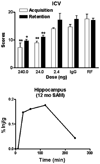Anti-amyloid beta protein antibody passage across the blood-brain barrier in the SAMP8 mouse model of Alzheimer's disease: an age-related selective uptake with reversal of learning impairment
- PMID: 17582399
- PMCID: PMC2080786
- DOI: 10.1016/j.expneurol.2007.05.005
Anti-amyloid beta protein antibody passage across the blood-brain barrier in the SAMP8 mouse model of Alzheimer's disease: an age-related selective uptake with reversal of learning impairment
Abstract
Amyloid beta protein (Abeta) levels are elevated in the brain of Alzheimer's disease patients. Anti-Abeta antibodies can reverse the histologic and cognitive impairments in mice which overexpress Abeta. Passive immunization appears safer than vaccination and treatment of patients will likely require human rather than xenogenic antibodies. Effective treatment will likely require antibody to cross the blood-brain barrier (BBB). Unfortunately, antibodies typically cross the BBB very poorly and accumulate less well in brain than even albumin, a substance nearly totally excluded from the brain. We compared the ability of two anti-Abeta human monoclonal IgM antibodies, L11.3 and HyL5, to cross the BBB of young CD-1 mice to that of young and aged SAMP8 mice. The SAMP8 mouse has a spontaneous mutation that induces an age-related, Abeta-dependent cognitive deficit. There was preferential uptake of intravenously administered L11.3 in comparison to HyL5, albumin, and a control human monoclonal IgM (RF), especially by hippocampus and olfactory bulb in aged SAMP8 mice. Injection of L11.3 into the brains of aged SAMP8 mice reversed both learning and memory impairments in aged SAMP8 mice, whereas IgG and IgM controls were ineffective. Pharmacokinetic analysis predicted that an intravenous dose 1000 times higher than the brain injection dose would reverse cognitive impairments. This predicted intravenous dose reversed the impairment in learning, but not memory, in aged SAMP8 mice. In conclusion, an IgM antibody was produced that crosses the BBB to reverse cognitive impairment in a murine model of Alzheimer's disease.
Figures





References
-
- Attems J, Jellinger KA. Olfactory tau pathology in Alzheimer's disease and mild cognitive impairment. Clinical Neuropathology. 2006;25:265–271. - PubMed
-
- Banks WA. Are the extracellular pathways a conduit for the delivery of therapeutics to the brain? Current Pharmaceutical Design. 2004;10:1365–1370. - PubMed
-
- Banks WA, Farr SA, Butt W, Kumar VB, Franko MW, Morley JE. Delivery across the blood-brain barrier of antisense directed againt amyloid β: reversal of learning and memory deficits in mice overexpressing amyloid precursor protein. J. Pharmacol. Exp. Ther. 2001a;297:1113–1121. - PubMed
-
- Banks WA, Farr SA, La Scola ME, Morley JE. Intravenous human interleukin-1α impairs memory processing in mice: Dependence on blood-brain barrier transport into posterior division of the septum. J. Pharmacol. Exp. Ther. 2001b;299:536–541. - PubMed
-
- Banks WA, Farr SA, Morley JE. Permeability of the blood-brain barrier to albumin and insulin in the young and aged SAMP8 mouse. Journal of Gerontology: Biological Science. 2000;55A:B601–B606. - PubMed
Publication types
MeSH terms
Substances
Grants and funding
LinkOut - more resources
Full Text Sources
Other Literature Sources
Medical

